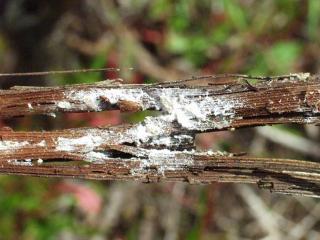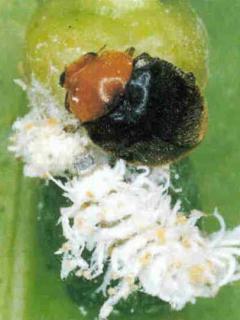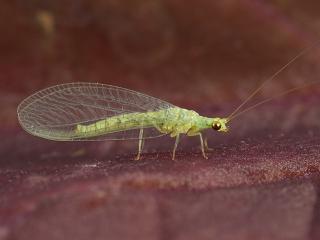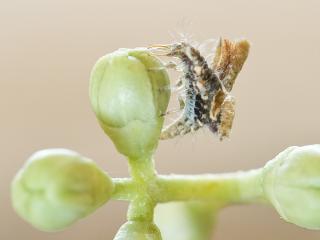Monitoring
Regions and crops with a history of mealybug infestation can avoid problems by monitoring to determine whether action is required, and the timing of such action to protect crops.
After an infestation of fruit is noticed during the growing season, the likelihood of a problem the following season can be assessed by checking under the bark of plants across the infested area during winter.

Overwintering mealybugs under bark leave behind white fibrous material, which can remain for over a year. Careful examination of the white residue with a ten times hand lens is required to confirm whether live mealybugs are present. To cover a reasonable area of orchard or vineyard, examine a plant for a set time such as two minutes to determine whether it is infested or not, then move to the next plant. Checking 25 plants across an infested area is a good way of assessing the proportion of plants infested with live mealybugs, and to determine if a problem will occur in the coming season. Further monitoring and possible action is suggested if more than 5% of plants are infested. For levels of 10% and above, inundative releases of commercially available predators or systemic insecticide should be considered.
When plants recommence growth in spring, check the underside of leaves in vineyards and in deciduous fruit tree crops check both the stem and stalk end of fruit to determine whether control action is required. At least fortnightly checking of 25 leaves or fruitlets/bunches across infested blocks will ensure both the abundance and timing of arrival of mealybugs is assessed to assist with making decisions on mealybug control.
Depending on the history and importance of mealybugs in a crop, an action theshhold of 5% plants infested may be appropriate. An increasing proportion of leaves or fruit infested over successive monitoring occasions is also a sign that action needs to be taken.
After harvest, mealybugs may continue to breed within crops. It is not clear whether controlling these populations helps with pest management the following season, but in table grapes up to two more generations of mealybugs can occur before crop senescence. If no control action is taken, it is likely the overwintering population of the pest will be much higher leading to a greater pest pressure the following season. This will increase the challenge for successful crop protection.

Synthetic pheromones for both species of mealybug have been identified and have been used for research to monitor the seasonal abundance of adult male mealybugs. For both species, male mealybugs were most abundant in late summer to early winter. Whether deploying pheromone traps as a monitoring tool to warn of potential pest populations of mealybugs is worthwhile is compromised because the lures are not easily obtained, confirming the small males on traps requires a microscope and the abundance of males does not readily indicate the presence of crawlers on crops because of the seasonality of males. More research is required to clarify whether deploying pheromone traps can help with mealybug monitoring.
Control
Cultural
Mealybug infestations of are most likely to commence when infested planting material is used. Ensuring plants are free of these insects or treating young plants to try to eliminate an infestation in the early stages of establishing a block will help with later pest management.
Because only male mealybugs can fly, this pest relies on mechanical transport to infest new areas. Cleaning machinery and farm items such as bins that may contain infested leaves or fruit residue brought onto a property and ensuring workers have not come from mealybug infested farms will help prevent the introduction of mealybugs.
Mealybugs prefer high humidity. If leaf plucking or summer pruning is an option for a susceptible crop, taking such action during the growing season will not only help create an undesirable environment but also open canopies to improve spray coverage if pesticides are used. Depending on the timing of leaf plucking, this may remove mealybugs that infested the canopy earlier, and help with reducing pest numbers.
In mealybug infested vineyards, bunches touching the cordon, crown or trunk are most likely to become infested because crawlers disperse from under the bark. If bunch thinning is a management practice, select bunches touching the cordon, crown or trunk for removal.
Ants have been claimed to assist mealybug infestations because they are attracted to the excretions of honey dew. It is more likely they occur together with mealybugs after an infestation is well established. Heavy infestations of mealybugs are not always associated with attendant ants.
Biological
Predators



Two species of predators are available from commercial rearing facilities for release into infested crops. They are the mealybug destroyer (Cryptolaemus montrouzieri) and green lacewing (Mallada signata). These predators are most applicable for use in winegrape vineyards where low numbers of mealybugs can be tolerated. In fresh fruit crops where cosmetic appearance is important, they are unlikely to reduce populations to acceptable levels, but may contribute to other control methods. The producers of these agents will be able to recommend whether their use is worthwhile for a particular situation, and the details of releases such as rate and number and timing of releases.
As well as the two species of predators available commercially, a range of naturally occurring predators are present in Western Australia. They include larvae of predatory flies and brown lacewing. They are most abundant near the end of the growing season when pesticide use has declined and mealybug numbers are likely to be high. The effect of such predators is considered to be minor.
Parasites

There are some species of wasps that occur naturally in Western Australia and attack mealybugs. They are most abundant after harvest and are thought to have a minor impact only on numbers of mealybugs. The identity of parasites that occur in WA is not known. With more knowledge on parasites that occur in WA, there may be opportunities to introduce species of parasites reported from mealybugs in eastern Australia.
Chemical
For other species of mealybug, the synthetic pheromones developed have been used in pest management as a means of disrupting mating. While synthetic pheromones are available for both longtailed mealybug and obscure mealybug, they have not been progressed into suitable products for the same management method.
General information on registered insecticides for control of mealybugs on any crop is available from the InfoPest website and from the Australian Pesticides and Veterinary Medicines Authority.
Grapevines
Information on insecticides registered for use against mealybugs on both table and wine-grapes is available from the Department of Primary Industries and Regional Development, Agriculture and Food Section, Western Australia Viticulture Spray Guide. Specific information for winegrapes is available from the Australian Wine Research Institute Dog Book.
Deciduous fruit tree crops
Information on insecticides registered for use against mealybugs on deciduous fruit tree crops is available from the Department of Agriculture and Food, Western Australia Pome and Summerfruit Orchard Spray Guide.


